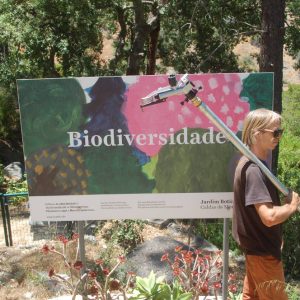Saturday 20th April 2024.

Do you know the beauty of wild orchids? Have you ever made a tea from lime blossom? Do you know the lavender-scented pillows that help you sleep? Those who love nature move within it carefully and, above all, mindfully. Because two feet can easily trample a valuable plant, a herb or a small, recently-planted tree. In a valley known as Esgravatadouro, the balance of nature was completely destroyed during several forest fires in 2003 and 2018, and, in order to protect the area from further destruction, the publisher of the magazine ECO123 bought the valley and declared it to be a botanical garden, christening it with the name of one of its founders, the late artist Carlos Abafa. Botanical gardens, however, are not created from one day to the next. It is a process that takes many years. But a transformation always starts with a first step, and then you subsequently plan many more steps. Are you interested?
The planting of trees in the Botanical Gardens of Lisbon began in 1873. It took until 1887 for the garden to begin to take shape. It then took another 100 years for it to slowly become what it is today, a World Heritage Site. Today, it is home to many different trees that were brought to Lisbon from overseas. In Monchique, however, native trees will take centre stage. A new diverse forest is to be planted on three hectares of land, consisting only of native species. The landscape is unique. From a spring situated on the publisher’s property, the water flows directly into a mountain stream that runs through the centre of the new botanical garden. There is enough space on both sides of the stream to plant roughly a thousand different trees on various historic terraces. Will you join in?
Who will help to plant the new Miyawaki forest?
The preparatory work has been done. A sprinkler system has been installed across the entire property to minimise or eliminate the risk of further destruction in the event of future forest fires. Eight sprinklers, screwed to three-metre-long galvanised steel pipes (1¼ inches wide), are supplied with rainwater from a tank with a capacity of 50m³, spraying across areas up to 30 metres wide in the new forest (in case of danger). The PVC pipes were laid in the ground, with the longest pipe being connected to a sprinkler 500 metres away at the end of the garden. All the other sprinklers are placed in between.
Esgravatadouro, Cooperativa do Ambiente CRL, is now looking for young climate enthusiasts to help plant its trees on the lowest terrace, creating a small new forest for the coming winter. What is a Miyawaki forest all about?
Professor Akira Miyawaki from Japan gave his name to a new type of forest. He lived from 1928 to 2021 and was a botanist and vegetation scientist by profession. Miyawaki travelled the world in the second half of the last century, studying forests on all continents of the planet in greater detail. Born in a small village in the west of the main Japanese island of Honshu, he attended a small school there and then trained for three years at an agricultural college in Tokyo.
After this, he studied at the Botanical Institute of Hiroshima University, receiving his doctorate in 1961. After teaching there from 1962 to 1973, he became the head of the Institute of Environmental Science and Technology at Yokohama State University from 1985 until his retirement in 1993, thereafter serving as Director of the Japan Centre for International Ecology Studies (JISE). In 2006, he won the BLUE PLANET Prize, worth more than 300,000 euros, for his work in solving global environmental problems, which involves planting tiny forests the size of a tennis court, either in urban areas or in badly destroyed rural landscapes, following a forest fire, for example. Within a few years, these areas are turned into small biotopes of high biodiversity through special preparation of the soil, a wide selection of tree species and their dense planting.
Miyawaki groves can achieve within a generation of 20 years what it would take normal large forests around a century to grow into. The editor of ECO123 began planting such a small forest in the winter of 2003 to 2004 after the first major forest fire in Monchique. The forest fire of 2018 was unable to destroy this small, humid forest of lime, oak, ash, almond and olive trees, some umbrella pines, a laurel tree, a black walnut tree and other species. Now, in 2024, Uwe Heitkamp wants to share his knowledge and experience with students and other interested people in Monchique.
Together with schoolteachers, their students and interested readers, ECO123 would like to plant around 200 young trees of 40 different species (some of them grown from seed) on a terrace measuring eight by ten metres, the size of a small house, and then continue to look after them. The project will be developed over three school years from 2024 to 2026, until such time as the small trees have grown to the height of the pupils and require less and less care, initially once a week and eventually once a month. The pupils will also learn why trees don’t have legs and feet. Because each tree is given its very own place in the forest. Where and why? Everyone will learn this together. In the new botanical forest garden in Esgravatadouro, a tree wants to be happy, without forest fires and with enough groundwater.
www.florestanativa.pt/
More information will be provided every Saturday morning by appointment at the Botanical Garden. Phone 918 818 108, email: editor@eco123.info
 Eco123 Revista da Economia e Ecologia
Eco123 Revista da Economia e Ecologia










